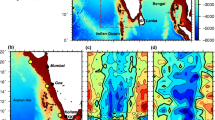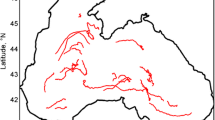Abstract
Knowledge of upper ocean currents is needed for trajectory forecasts and is essential for search and rescue operations and oil spill mitigation. This paper addresses effects of surface waves on ocean currents and drifter trajectories using in situ observations. The data set includes colocated measurements of directional wave spectra from a wave rider buoy, ocean currents measured by acoustic Doppler current profilers (ADCPs), as well as data from two types of tracking buoys that sample the currents at two different depths. The ADCP measures the Eulerian current at one point, as modelled by an ocean general circulation model, while the tracking buoys are advected by the Lagrangian current that includes the wave-induced Stokes drift. Based on our observations, we assess the importance of two different wave effects: (a) forcing of the ocean current by wave-induced surface fluxes and the Coriolis–Stokes force, and (b) advection of surface drifters by wave motion, that is the Stokes drift. Recent theoretical developments provide a framework for including these wave effects in ocean model systems. The order of magnitude of the Stokes drift is the same as the Eulerian current judging from the available data. The wave-induced momentum and turbulent kinetic energy fluxes are estimated and shown to be significant. Similarly, the wave-induced Coriolis–Stokes force is significant over time scales related to the inertial period. Surface drifter trajectories were analysed and could be reproduced using the observations of currents, waves and wind. Waves were found to have a significant contribution to the trajectories, and we conclude that adding wave effects in ocean model systems is likely to increase predictability of surface drifter trajectories. The relative importance of the Stokes drift was twice as large as the direct wind drag for the used surface drifter.







Similar content being viewed by others
References
Aamo OM, Jensen H (1997) Operational use of ocean surface drifters for tracking spilled oil. In: Proceedings of the 20th Arctic and Marine Oil Spill Program (AMOP) technical seminar, Vancouver, Canada
Alford MH, Gregg MC (2001) Near-inertial mixing: modulation of shear, strain and microstructure at low latitude. J Geophys Res 106(C8):16947–16968. doi:10.1029/2000JC000370
Ardhuin F, Marie L, Rascle N, Forget P, Roland A (2009) Observation and estimation of Lagrangian, Stokes, and Eulerian currents induced by wind and waves at the sea surface. J Phys Oceanogr 39(11):2820–2838. doi:10.1175/2009JPO4169.1
Belore R, Trudel K, Morrison J (2011) Weathering, emulsification, and chemical dispersibility of Mississippi Canyon 252 crude oil: field and laboratory studies. In: 2011 international oil spill conference. Portland, Oregon
Breivik O, Allen AA (2008) An operational search and rescue model for the Norwegian Sea and the North Sea. J Marine Syst 69(1–2):99–113. doi:10.1016/j.jmarsys.2007.02.010
Breivik O, Allen AA, Maisondieu C, Roth J (2011) Wind-induced drift on objects at sea: the leaway field method. Appl Ocean Res 33:100–109. doi:10.1016/j.apor.2011.01.005
Broström G, Christensen KH, Weber JEH (2008) A quasi-Eulerian, quasi-Lagrangian view of surface-wave-induced flow in the ocean. J Phys Oceanogr 38(5):1122–1130. doi:10.1175/2007JPO3702.1
Carniel S, Warner J, Chiggiato J, Sclavo M (2009) Investigating the impact of surface wave breaking on modeling the trajectories of drifters in the northern Adriatic Sea during a wind-storm event. Ocean Model 30(2–3):225–239. doi:10.1016/j.ocemod.2009.07.001
Craig PD, Banner ML (1994) Modeling wave-enhanced turbulence in the ocean surface layer. J Phys Oceanogr 24(12):2546–2559. doi:10.1175/1520-0485(1994)024<2546:MWETIT>2.0.CO;2
Craik ADD (1982) The drift velocity of water waves. J Fluid Mech 116:187–205. doi:10.1017/S0022112082000421
Craik ADD, Leibovich S (1976) Rational model for Langmuir circulations. J Fluid Mech 73:401–426. doi:10.1017/S0022112076001420
Daniel P, Jan G, Cabioc’h F, Landau Y, Loiseau E (2002) Drift modeling of cargo containers. Spill Sci Technol B 7(5–6):279–288. doi:10.1016/S1353-2561(02)00075-0
Datawell (2007) Datawell waverider reference manual. Technical report, Datawell BV. www.datawell.nl. Accessed 20.09.2011
Davis RE (1985a) Drifter observations of coastal surface currents during code: the method and descriptive view. J Geophys Res 90(C3):4741–4755. doi:10.1029/JC090iC03p04741
Davis RE (1985b) Drifter observations of coastal surface currents during code: the statistical and dynamical views. J Geophys Res 90:4756–4772. doi:10.1029/JC090iC03p04756
Emery W, Thomson RE (1997) Data analysis methods in physical oceanography. Elsevier, Amsterdam
Grant ALM, Belcher SE (2009) Characteristics of Langmuir turbulence in the ocean mixed layer. J Phys Oceanogr 39(8):1871–1887. doi:10.1175/2009JPO4119.1
Janssen PAEM (1989) Wave-induced stress and the drag of air flow over sea waves. J Phys Oceanogr 19:745–754
Jenkins AD (1989) The use of a wave prediction model for driving a near-surface current model. Ocean Dyn 42:133–149. doi:10.1007/BF02226291
Jones B, Boudjelas S, Michelson-Jacob E (1997) Topographic steering of winds in vestfjorden. Weather - London 52(10):304–311
Komen GJ, Cavaleri L, Doneland M, Hasselmann K, Hasselmann S, Janssen PAE (1994) Dynamics and modelling of ocean waves. Cambridge University Press, Cambridge
Liu Y, Weisberg RH (2011) Evaluation of trajectory modeling in different dynamic regions using normalized cumulative Lagrangian separation. J Geophys Res 116(C9):C09013. doi:10.1029/2010JC006837
Longuet-Higgins MS (1953) Mass transport in water waves. Philos Trans R Soc 245:535–581
Longuet-Higgins M, Stewart R (1964) Radiation stress in water waves; a physical discussion with applications. Deep-Sea Res 11:529–562. doi:10.1016/0011-7471(64)90001-4
Michelson-Jacob G, Sundby S (2001) Eddies of Vestfjorden, Norway. Cont Shelf Res 21(16–17):1901–1918. doi:10.1016/S0278-4343(01)00030-9
O’Donnell J, Allen A, Murphy D (1997) An assessment of the errors in lagrangian velocity estimates obtained by fgge drifters in the Labrador current. J Atmos Ocean Technol 14(2):292–307. doi:10.1175/1520-0426(1997)014<0292:AAOTEI>2.0.CO;2
Pawlowicz R, Beardsley B, Lentz S (2002) Classical tidal harmonic analysis including error estimates in Matlab using t_tide. Comput Geosci 28(8):929–937. doi:10.1016/S0098-3004(02)00013-4
Perrie W, Tang CL, Hu Y, DeTracy BM (2003) The impact of waves on surface currents. J Phys Oceanogr 33(10):2126–2140. doi:10.1175/1520-0485(2003)033<2126:TIOWOS>2.0.CO;2
Phillips OM (1977) The dynamics of the upper ocean. Cambridge University Press, London
Polton JA, Lewis DM, Belcher SE (2005) The role of wave-induced Coriolis–Stokes forcing on the wind-driven mixed layer. J Phys Oceanogr 35(4):444–457. doi:10.1175/JPO2701.1
Rascle N, Ardhuin F (2009) Drift and mixing under the ocean surface revisited: stratified conditions and model-data comparisons. J Geophys Res 114(C2):C02016. doi:10.1029/2007JC004466
Roed L (1980) Curvature effects on hydraulically driven inertial boundary currents. J Fluid Mech 96(2):395–412. doi:10.1017/S0022112080002182
Saetra Ø, Albretsen J, Janssen PAEM (2007) Sea-state-dependent momentum fluxes for ocean modeling. J Phys Oceanogr 37(11):2714–2725. doi:10.1175/2007JPO3582.1
Smith S (1988) Coefficients for sea surface wind stress, heat flux, and wind profiles as a function of wind speed and temperature. J Geophys Res 93(C12)(2):311–326. doi:10.1016/0021-9991(88)90175-1
Stokes GG (1847) On the theory of oscillatory waves. Trans Camb Philos Soc 8:441–473
Sundby S (1982) Fresh water budget and wind conditions. In: Investigations in Vestfjorden 1978. ftp://ftp.imr.no/biblioteket/files/havforsk/fh_1982_01.pdf. Accessed 21.09.2011, Fisken og Havet, 1982: 16 s. [In Norwegian, English abstract]
Tang C, Perrie W, Jenkins A, DeTracey B, Hu Y, Toulany B, Smith P (2007) Observation and modeling of surface currents on the Grand Banks: a study of the wave effects on surface currents. J Geophys Res 112(C10):C10025. doi:10.1029/2006JC004028
Weber J, Broström G, Saetra O (2006) Eulerian vs Lagrangian approaches to the wave-induced transport in the upper ocean. J Phys Oceanogr 36:2106–2118. doi:10.1175/JPO2951.1
Weber J, Broström G, Christensen K (2008) Radiation stress and depth-dependent drift in surface waves with dissipation. Int J Offshore Polar 18(1):8–13
Weber JE (1983) Steady wind- and wave-induced currents in the open ocean. J Phys Oceanogr 13(3):524–530. doi:10.1175/1520-0485(1983)013<0524:SWAWIC>2.0.CO;2
Weber JE, Christensen KH, Denamiel C (2009) Wave-induced set-up of the mean surface over a sloping beach. Cont Shelf Res 29:1448–1453. doi:10.1016/j.csr.2009.03.010
Acknowledgements
We wish to thank Ilker Fer and Øyvind Sætra for helpful discussions. We also gratefully acknowledge financial support from the Research Council of Norway through the grants 196438 (BioWave) and 207541 (OilWave), as well as the Gulf of Mexico Research Initiative Deep-C Consortium. We also thank the Royal Norwegian Navy for supplying us with the ADCP instrument, as well as Steinar Hansen from the Norwegian Coastal Administration for providing necessary logistics. We are grateful for the constructive comments of the anonymous reviewers, who helped to increase the quality of this paper significantly.
Author information
Authors and Affiliations
Corresponding author
Additional information
Responsible Editor: Arthur Allen
This article is part of the Topical Collection on Advances in Search and Rescue at Sea
Rights and permissions
About this article
Cite this article
Röhrs, J., Christensen, K.H., Hole, L.R. et al. Observation-based evaluation of surface wave effects on currents and trajectory forecasts. Ocean Dynamics 62, 1519–1533 (2012). https://doi.org/10.1007/s10236-012-0576-y
Received:
Accepted:
Published:
Issue Date:
DOI: https://doi.org/10.1007/s10236-012-0576-y




